Inexperienced foragers might have trouble distinguishing between the healthy American Ginseng plant and the poisonous Virginia Creeper. The two plants have much in common, but we will discuss both plants, highlighting the differences so that you can tell them apart reliably.
American Ginseng
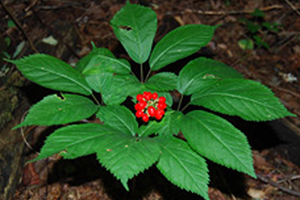 American Ginseng, also known as Panax ginseng, is a perennial native to the eastern United States.
American Ginseng, also known as Panax ginseng, is a perennial native to the eastern United States.
It is hardy in USDA zones 4 to 8, but it has been widely harvested and is currently an endangered species in the wild. It prefers shady spots with nutrient-rich, moist soil.
Related: Edibility Test: Find Out Which Backyard Weeds Are Edible
Virginia Creeper
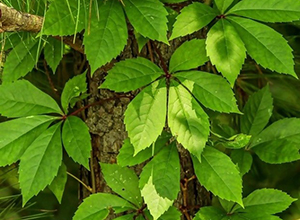 The Virginia creeper, also known as Parthenocissus quinquefolia, grows as a deciduous woody vine in the eastern United States.
The Virginia creeper, also known as Parthenocissus quinquefolia, grows as a deciduous woody vine in the eastern United States.
It is hardy in USDA Zones 3 to 9. It thrives in wooded areas and ravines, and can be invasive. Virginia creeper grows in a wide range of conditions.
Growth Habits of the Plants
The growth habits of the plants are very different. Ginseng grows low to the ground achieving 10 to 15 inches in height and clustering in wooded and rocky areas. The leaf prongs are upright, but they do not branch.
In contrast, Virginia creeper is a climbing vine, using tendrils to grab hold of surfaces and other plants. Virginia creeper grows up to 50 feet in length, sprawling along the ground or climbing on trees, walls, fences, and other vertical surfaces.
Use caution when identifying the plants. When Virginia creeper has nothing to climb on, it grows along the ground and can look like American ginseng.
Related: Similar to Morphine: The Best Natural Painkiller that Grows in Your Backyard
Leaves
Both plants are members of the Ivy family. They have similar leaves, oblong and toothed.
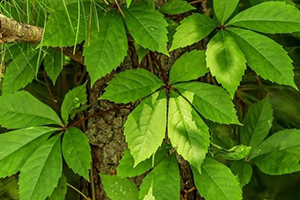
The Virginia creeper leaflets are more coarsely serrated, and the teeth do not continue around the base of the leaflet. Also the leaves are broad in the middle.
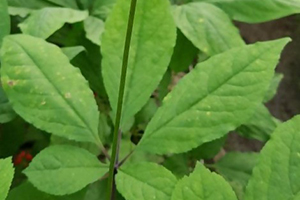
American ginseng leaf serrations extend around the entire leaf, and the serrations are smaller. The leaves are slimmer overall and broadest close to the tip.
The leaf attachments are also different, with the ginseng leaflets growing from petioles that attach to the central stem. Virginia creeper leaflets sprout from a central point and connect directly to the stem.
Both kinds of leaves are compound with five leaflets each. The ginseng leaves grow in clusters of 3 or more compound leaves, while the Virginia creeper leaves grow singly. The five leaflets of the Virginia creeper are approximately equal in size, while the ginseng leaflets consist of three larger leaflets in the center and a smaller leaflet to each side.
Another difference is very evident in the fall when the leaves of the Virginia creeper turn brilliant red, while the American ginseng leaves turn yellow.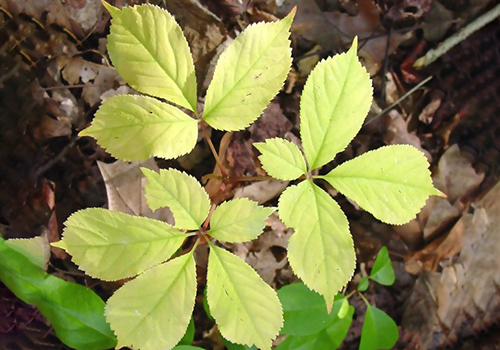
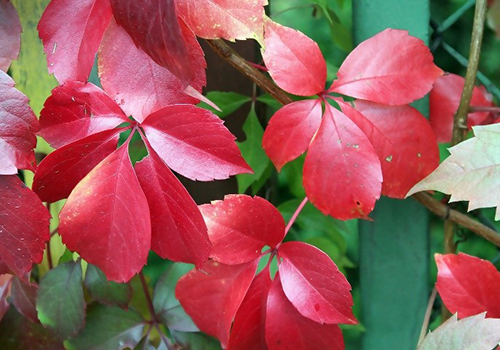 The leaves of Virginia creeper are irritating to some people, but not everyone is sensitive to the plant.
The leaves of Virginia creeper are irritating to some people, but not everyone is sensitive to the plant.
Berries
The fruits ripen in mid to late summer and are especially evident in the fall. The dark blue or black Virginia creeper berries are poisonous and can be fatal when eaten. The birds like them, but teach your children to stay away. In contrast, ginseng produces red berries.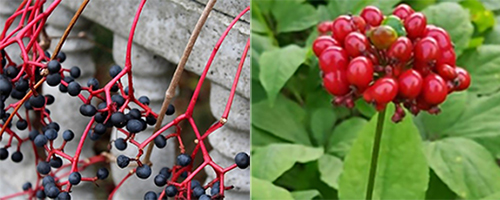 American ginseng is a valuable plant with many medicinal uses. Because of this, it has been over-harvested and is considered endangered in many states. If you see a plant that you believe to be American ginseng, you must be careful to verify its identity carefully.
American ginseng is a valuable plant with many medicinal uses. Because of this, it has been over-harvested and is considered endangered in many states. If you see a plant that you believe to be American ginseng, you must be careful to verify its identity carefully.
Harvesting wild ginseng is legal, but only during specific periods, usually in the fall. Check your state laws for more information. Ginseng hunters should plant the mature berries whenever they are found. This practice will help bring back this valuable plant.
American ginseng grows well in your garden in rich soil and partial shade to full shade. The plant grows from a healthy piece of rootstock or seed. The seeds take a long time to germinate, up to two years.
Related: If You See this Weed Growing in Your Yard, Don’t Pick it – Here’s Why
Harvesting American Ginseng
When harvesting, look for mature plants with at least four sets of compound leaves. Younger roots are too small. Follow these rules when digging ginseng:
- Know the laws in your area
- Only harvest mature plants
- Harvest ginseng in the fall after the seeds turn dark red
- Dig carefully, keeping the roots intact
- Plant all the berries to grow new plants
By harvesting carefully, you assure that the species survives and thrives for future generations.
You may also like:
 7 Backyard Plants That Can Kill You
7 Backyard Plants That Can Kill You
The U.S. Army’s Forgotten Food Miracle (Video)
How To Tell the Difference Between the Healing “Queen Anne’s Lace” and Deadly “Hemlock”
9 Natural Remedies that People with Diabetes Will Find Useful

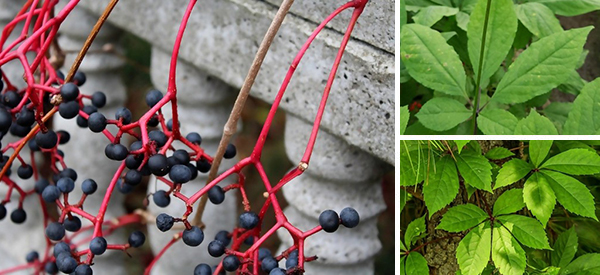




















You’d have to be pretty lousy at plant identification to mistake a vine, generally growing up the side of a tree, to a single plant growing on the forest floor.
What is a lot more common is to mix up Virginia creeper with poison oak vines, since they look very similar except for the number of leaves in a cluster (5 vs 3)
Leaves of five stay alive, leaves of three flee. I now understand this old country saying.
Thanks
A far better way to learn about identification of useful herbs is to learn the characteristics of the useful herbs inside out and upside down-i.e. thoroughly. Then one will not mistake the toxic look alike for the useful herb. By trying to learn the differences between the two, you set yourself up for the possibility of confusion when you see the plant, especially for beginners. If you thoroughly know what the plant that you want to harvest looks like, you will not mistake it for the look alike, but if you have the description of the look alike also ingrained in your mind, there is the potential for you to make an error.
The Virginia creeper is also used to treat Poison Ivey, bruise the back of the leaves and rub then on the area. I have been using this for years.
It’s amazing to me how many plants have purple fruit. The Virginia creeper berries look like what I remember 70 some years later as poison sumac. The urban legend that was gospel among the woods rats that comprised our little gang was that poison sumac berries would kill you before you could get home if you ate them.
Most wild fruit that grew in the woods I frequented as a child, even if not poisonous were usually so bitter they were better left alone. Even the wild apples would pucker your mouth.
I never thought about it, but yeah, the leaf brackets are the same. where it had nothing to climb, I’ve seen creeper grow like ginseng. The roots can be similar when the plants are young. A neighbor stole a lot of both from a farmer’s woods and when he tried to sell it, the herbalist told him some of the roots were wrong. He argued, she called the cops and he ran. When the farmer was gold by her, he had the thief arrested, but by then the creep got sick eating the wrong roots. niio
I think the hippies used to say, “karma is a bitch.”
they were being too kind. I always liked ironic justice. King saul falling on his sword, dems shrieking in mourning for an evil man, Virginia trying to wipe out the 2nd amendment. God is laughing at liberals, again. niio
We bought a house on 1//2 acre, the wooded & brush area & yard were overran with Va. Creeper. I saw it kill of a 40 year old Black walnut tree & a couple of younger Maples b4 I was able to get under control. I also learned that I was allergic to it just like I am to poison Ivy, oak & sumac…BE CAREFUL when you handle it.